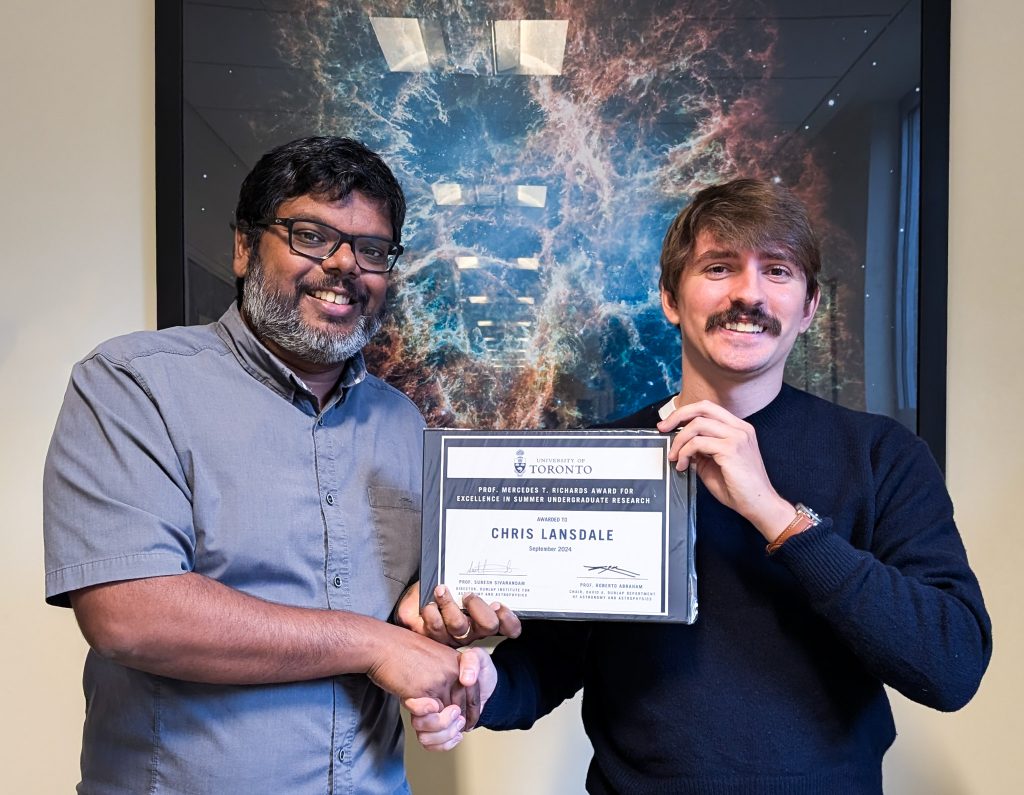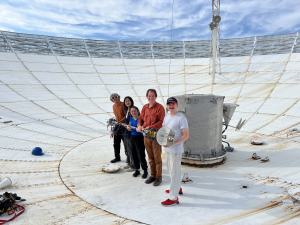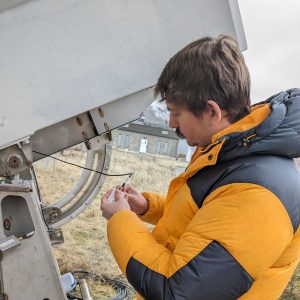
Dunlap Institute director Suresh Sivanandam (left) presents the award to Chris Lansdale. Credit: Dunlap Institute.
By Ilana MacDonald, Dunlap Institute for Astronomy & Astrophysics
Chris Lansdale, who recently completed his undergraduate degree in Engineering Science at the University of Toronto, was the recipient of the third annual Mercedes T. Richards Award for Excellence in Summer Undergraduate Research.
Over the summer of 2024, Lansdale participated in the Astronomy & Astrophysics 2024 Summer Undergraduate Research Program (SURP) under the supervision of Dr. Albert Lau and Prof. Juan Mena-Parra of the Dunlap Institute for Astronomy & Astrophysics, where he worked on developing hardware and software for the CHORD radio telescope.
“Chris’s contributions to the CHORD project’s power distribution and analog signal chain design are remarkable achievements that underscore his talent and dedication,” says Lau. “We are thrilled to see his hard work and ingenuity recognized with the Mercedes T. Richards Award.”

An artist’s impression of the CHORD radio telescope as it will look when it is completed, next to the CHIME telescope on the right. Credit: Tracy Zhuo
CHORD, which stands for the Canadian Hydrogen Observatory and Radio-transient Detector, is an array of 512 six-meter radio dishes currently under construction at the Dominion Radio Astrophysical Observatory near Penticton, BC. It will be an order of magnitude more powerful than its predecessor CHIME.
The main purposes of CHORD would be to localize thousands of Fast Radio Bursts (FRBs), flashes of radio light lasting only fractions of a second whose extra-galactic origin is still a mystery, and to map the large-scale structure of the universe through emission from neutral hydrogen.
Lansdale’s research, which he presented at the end of the summer in a poster entitled “CHORD’s Analog Receive Chain”, was primarily focused on developing the power distribution system for the radio telescope array, as well as completing the design of its analog chain, that is, the components that process analog signals from the telescope prior to the digital processor.
These two elements of his work would together allow CHORD to amplify and detect the faint signals it receives from space and pave the way for a new era of FRB science.
“Having the opportunity to work in Professor Mena-Parra’s lab this summer with Albert was a life changing experience,” says Lansdale. “I’ve gained so much knowledge in such a short time that I would have never been able to do in industry and made many great connections along the way.”
Cutting edge research always comes with interesting challenges, and Lansdale’s experience this summer exemplified this fact. Near the end of his project, he and his collaborators had the chance to go up to the Algonquin Radio Observatory (ARO), located in the middle of Algonquin National Park. Their goal was to install a new prime focus for the 46-meter radio dish that had been designed in their lab.
In the days leading up to their departure, much of the crew fell ill, and the team had to scramble to assemble all their equipment. Even getting up to the observatory was a challenge, but they managed to pull it off!

Lansdale (right) and collaborators (left to right) Ben Quine, Jessica Meng, Sophia Da Costa, and Marten van Kerkwijk, at the Algonquin Radio Observatory stand atop the 46-meter radio dish. Credit: Sophia Di Costa
“The fact that the few of us that remained managed to get everything ready in time and assemble and install a working feed in the little time we had was nerve wracking but exciting!” Lansdale recalls.
The Award includes a $2000 cash prize. Nominations can be made during the SURP program, which runs from May to August every year and is administered by the David A. Dunlap Department of Astronomy and Astrophysics and the Dunlap Institute for Astronomy & Astrophysics at the University of Toronto.
About the Award
The Professor Mercedes T. Richards Award for Excellence in Summer Undergraduate Research is awarded annually to a SURP student who has demonstrated outstanding achievement and growth in astronomy research.
This award honours the memory of Professor Mercedes T. Richards (1955-2016) and her tireless efforts to advance the fields of physics and astronomy. Originally from Jamaica, Prof. Richards earned her PhD in Astronomy and Astrophysics at the University of Toronto in 1986.
Prof. Richards performed groundbreaking research across computational astrophysics, stellar astrophysics, and exoplanets and brown dwarfs. In fact, she was the first astronomer to use the process of tomography to observe binary star systems, and model how gases flow around stars in binary systems.
—
For more information, please contact:
Ilana MacDonald
Public Outreach, Communications and Events Strategist
Dunlap Institute for Astronomy & Astrophysics
University of Toronto
ilana.macdonald@utoronto.ca

